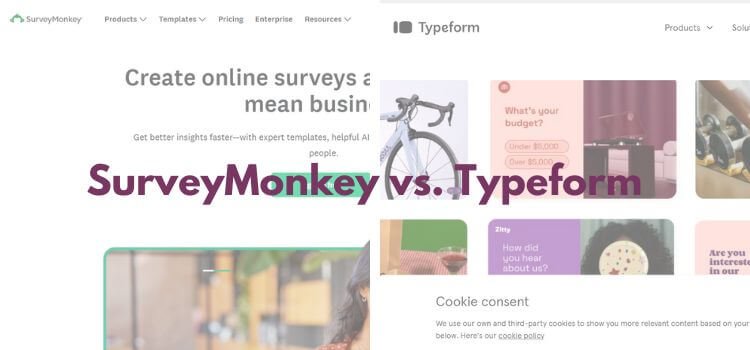If you’re comparing SurveyMonkey vs Typeform for your next survey project, you’re in the right place. As someone who’s used both platforms, I can tell you that each has its strengths depending on your needs. Whether you’re creating a quick poll or a detailed customer feedback survey, these two tools offer different features that might suit your goals.
In this post, I’ll share my personal experiences with both, highlight their key differences, and help you decide which one is the right fit for your next project. By the end, you’ll have a clear picture of which survey platform works best for you. Let’s get started!
Table of Contents
What is SurveyMonkey?
SurveyMonkey is a veteran in the online survey world. Since its launch in 1999, it has grown to become one of the most trusted platforms for creating surveys, polls, and quizzes. It’s known for its user-friendly interface, large range of question types, and powerful data analysis tools. Whether you’re creating simple feedback forms or detailed market research surveys, SurveyMonkey offers a robust solution.
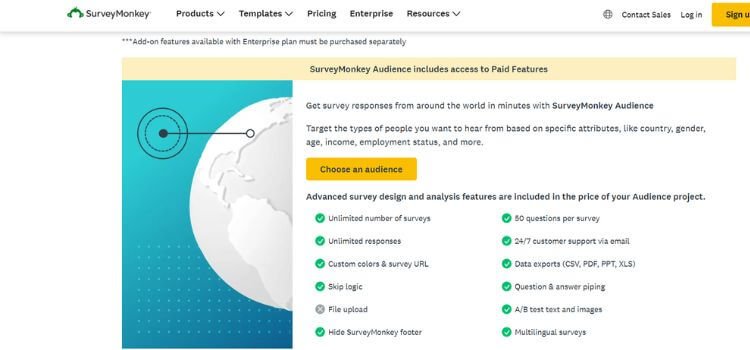
Key Features:
- Advanced analytics: Powerful reporting tools for in-depth data analysis.
- Question variety: Offers a wide range of question types, such as multiple-choice, matrix, and open-ended.
- Customizable templates: Over 150 pre-built templates to help you get started quickly.
- Integrations: Connects with tools like Google Sheets, Salesforce, and Mailchimp.
- Security and compliance: Robust data security measures, including GDPR compliance.
What is Typeform
Typeform, on the other hand, is a more recent platform, founded in 2012. It is known for its sleek and modern design, focusing on creating surveys that are both visually appealing and interactive. Typeform takes a unique approach by using a one-question-at-a-time format, which tends to result in higher engagement from respondents. It’s especially popular among marketers and designers who prioritize user experience.
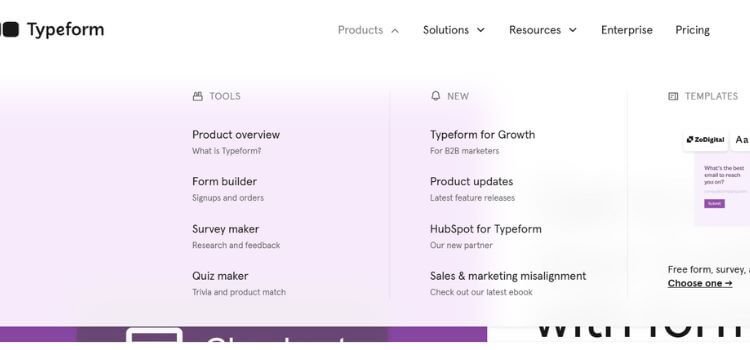
Key Features:
- Visually appealing design: Sleek, minimalist surveys that enhance the respondent’s experience.
- Interactive format: The one-question-at-a-time approach increases engagement.
- Customizable: Typeform offers high customization with themes, logos, and colours.
- Logic jumps: Ability to personalize the survey experience based on responses.
- Integrations: Works with a wide variety of tools like Google Sheets, Zapier, and Mailchimp.
Read Also: More Good Reviews Lifetime Deal
Typeform vs. SurveyMonkey: Key Differences
To make the comparison clearer, here’s a table summarizing the key differences between SurveyMonkey and Typeform:
| Feature | SurveyMonkey | Typeform |
|---|---|---|
| User Interface | Simple, functional, and straightforward | Sleek, minimalist, and visually engaging |
| Survey Design | Standard survey format (question list) | One-question-at-a-time, more interactive |
| Templates | 150+ pre-built templates | 50+ pre-built templates |
| Customization | Limited customization in design | Highly customizable design and branding |
| Question Types | Wide variety of questions (multiple-choice, open-ended, etc.) | Similar question types, but with more creative options |
| Logic and Branching | Advanced logic and skip logic options | Conditional logic and “logic jumps” for dynamic surveys |
| Data Analysis | Strong reporting tools with in-depth analysis | Basic reporting with visual insights |
| Integrations | Integrates with Google Sheets, Mailchimp, Salesforce, and others | Works with Google Sheets, Zapier, and many others |
| Pricing | Free plan with limited features, paid plans from $25/month | Free plan available, paid plans start at $35/month |
| Mobile Optimization | Fully mobile-friendly surveys | Fully responsive and mobile-optimized |
| Support | 24/7 email support, phone support for higher tiers | 24/7 email support, and phone support for higher tiers |
Which One is Right for You?
Now that we’ve compared the core features, let’s break it down and help you decide which platform is best for you.
When to Choose SurveyMonkey:
- For Detailed Surveys: If you need to create long surveys with a wide range of question types and in-depth reporting tools, SurveyMonkey is a strong choice.
- Data Analysis: SurveyMonkey excels in data analysis and reporting. If you’re looking for deep insights into your survey results, this platform has the tools you need.
- Long-Term Use: With its affordable pricing and advanced features, SurveyMonkey is a good choice for businesses that need to create surveys regularly over time.
- Security & Compliance: If security and privacy (such as GDPR compliance) are important, SurveyMonkey offers strong features to keep your data safe.
When to Choose Typeform:
- Engagement & Design: If you want to create surveys that are visually appealing and interactive, Typeform is perfect. Its one-question-at-a-time format can increase respondent engagement and completion rates.
- Branding: Typeform offers high customization for surveys, making it ideal if you want your survey to match your brand’s look and feel.
- Short, Creative Surveys: If your surveys are short or if you want to stand out with creative designs and smooth user experiences, Typeform’s minimalist interface works wonders.
- Higher Engagement: Due to its interactive features, Typeform is especially great for events, customer feedback, and gathering opinions where respondent engagement is key.
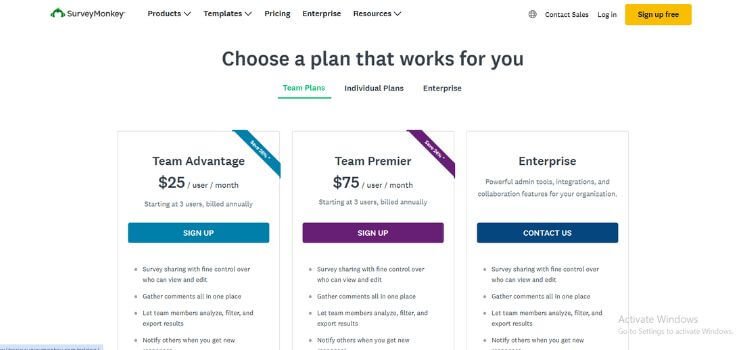
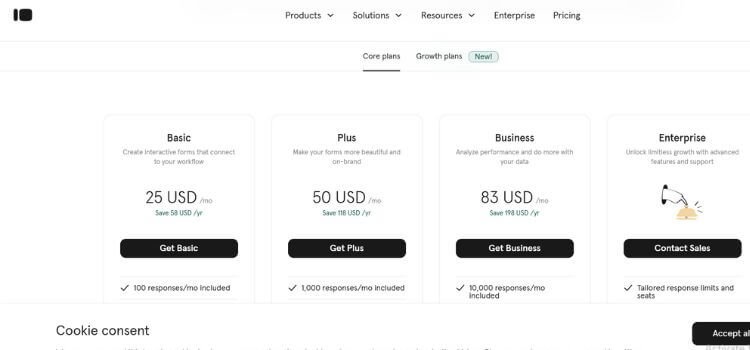
FAQ: SurveyMonkey vs Typeform
Which platform is easier to use, SurveyMonkey or Typeform?
Typeform is known for its modern, one-question-at-a-time approach, making it more engaging and visually appealing. SurveyMonkey, while user-friendly, has a more traditional, straightforward interface.
Are there free plans available for both SurveyMonkey and Typeform?
Yes, both platforms offer free plans. SurveyMonkey allows 10 questions and 100 responses per survey, while Typeform offers unlimited surveys but limits you to 10 questions and 100 responses per month.
Can I customize the look of my surveys in SurveyMonkey and Typeform?
Typeform offers more design flexibility, allowing you to create visually appealing surveys with images and videos. SurveyMonkey offers basic customization, like adding logos and changing colours, but it’s more limited.
Which platform has better data analysis tools, SurveyMonkey or Typeform?
SurveyMonkey has stronger data analysis tools with advanced reporting options. Typeform is better for gathering responses but offers fewer analysis features.
Which platform is better for collecting customer feedback, SurveyMonkey or Typeform?
It depends on your goals. SurveyMonkey is great for detailed feedback with powerful reporting tools, while Typeform excels at creating engaging, visually appealing surveys to encourage higher response rates.
Final Word
Both SurveyMonkey and Typeform are excellent survey tools, but the best choice depends on your goals. If you’re looking for a traditional, feature-rich tool that can handle everything from detailed research to simple feedback forms, SurveyMonkey is a reliable option. On the other hand, if you want a visually stunning, user-friendly experience that increases engagement and makes your surveys feel more like a conversation, Typeform is the way to go.
Ultimately, it comes down to what you need—whether that’s deep data analysis, easy customization, or engaging and interactive design. Try both and see which one feels like the best fit for your survey goals!
This post contains affiliate links. I may earn a commission if you make a purchase through them, at no extra cost to you.

